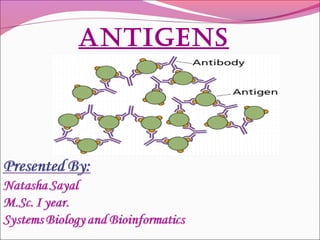
Antigen
- 1. ANTIGENs
- 2. I. Definition of antigens Antigens are the substance which when introduced parenterally into the body stimulates the production of an antibody with which it reacts specifically and in an observable manner. Specificity is referred to that, immune responses are directed toward and able to distinguish between distinct antigen or small parts of macromolecular antigens. Ab1 Ab2 Ab3
- 3. How Antigen enters Sites of antigen entry Sites of initial antigen capture Sites of antigen collection and capture
- 4. 1. Immunogen: the antigen that induce specific immune response 2.Tolerogen: antigen that induce Immunologic tolerance Immunologic tolerance is unresponsiveness to an antigen that is induced by prior exposure to that antigen. 3. Allergen: antigen that induce Anaphylaxis (severe immediate hypersensitivity reaction occurring as a result of rapid generalized mast-cell granulation) 4. Vaccine: antigens that induce a protection immune response against microbes and are used to prevent diseases
- 5. Immunogenecity vs Antigenicity Immunogenicity is the ability to induce a humoral and/or cell-mediated immune response. B cells + antigen effector B cells + memory B cells T cells + antigen effector T cells + memory T cells Antigenicity is the ability to combine specifically with the final products of the immune response (i.e. secreted antibodies and/or surface receptors on T- cells). Although all molecules that have the property of immunogenicity also have the property of antigenicity, the reverse is not true.
- 6. .
- 7. I) Nature of Immunogen: Foreigness: In order to elicit an immune response a molecule must be recognized as nonself by the host. What kinds of substances can be foreignness to immune system? (1) Heterogeneous substances Various pathogens, xenoantigeneic tissues. (2) Allogeneic substance grafted allogeneic tissues or organs. (3)Autoantigenic components that never contact with lymphocytes during embryo period. Molecular Size: Usually the bigger the better. Molecules with MW of 5000-10000 are poor immunogens with the best immunogens being about 100,000 D.
- 8. Chemical complexity : Just because a molecule is large, if its a polymer of a single amino acid or sugar it tends to lack immunogenicity. The addition of aromatic amino acids such as tyrosine and phenylalanine has a profound effect on the immunogenicity of these synthetic polymers. All 4 levels of protein organization , primary, secondary, tertiary, and quaternary- contribute to the structural complexity of a protein and hence affect its immunogenicity. Degradability: Macromolecules that cannot be degraded and processed by Antigen presenting cells are poor immunogens II) Contribution of the Biological System: which includes 1.Genotype of the recipient animal: The genes that code for MHC molecules, T cell receptors, and B cell receptor all play a central role in determining the degree of immune responsiveness to an antigen. 2. Age : can also influence immunogenicity. Usually the very young and the very old have a diminished ability to mount and immune response in response to an immunogen.
- 9. III) Method of Administration Dosage: Too low a dose of Antigen will fail to activate enough lymphocytes for a response whereas too high a dose can overwhelm the system and cause the lymphocytes to enter a nonresponsive state. Route : Generally the subcutaneous route is better than the intravenous or intragastric routes. The route of antigen administration can also alter the nature of the response Adjuvants : Adjuvants are substances that when mixed with an Antigen serve to enhance the immunogenicity of that Antigen. Adjuvants are often water in oil mixtures with various bacterial components added. Aluminum potassium sulfate (alum) is the only approved adjuvant for human use.
- 10. Classification of Antigens Complete antigen Which contains both immunogenicity and antigenicity Incomplete antigen Contains only antigenicity e.g. Haptens Proteins Majority of immunogens are proteins (pure proteins or they may be glycoproteins or lipoproteins). Proteins are usually very good immunogens. Polysaccharides Pure polysaccharides and lipopolysaccharides are good immunogens. Nucleic Acids Nucleic acids are usually poorly immunogenic. However, they may become immunogenic when single stranded or when complexed with proteins. Lipids In general lipids are non-immunogenic, although they may be haptens. TD-Ag (thymus dependent antigens ) TI-Ag (thymus independent antigens)
- 11. 1. Antigen determinants (epitope) The portion of antigen molecules which can be specifically recognized by antibody or antigenic receptor of lymphocytes.
- 12. Classification of antigenic determinant 1.According to the structure of Antigen determinants Conformational determinants : are formed by amino acid residues that aren’t in a sequence but become spatially juxtaposed in the folded protein Sequential (or linear) determinants Epitopes formed by several adjacent amino acid residues are called linear determinants.
- 13. 2.According to types of cells recognizing antigenic determinants T cell epitope B cell epitope Receptor TCR BCR Nature short peptide proteins, polysaccharides Size 8-17 amino acid residues 5-15 amino acid residues or 5-7 monosaccharides Types linear epitope conformational epitope or linear epitope Position any position in antigen mostly exist on the surface of antigen
- 14. References 1.Immunology by Kubby 2.www.google.com- antigens.pdf